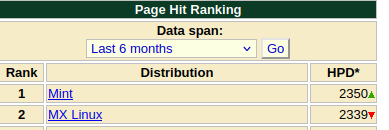So in 2013 I had a Windows XP computer that hard drive had died. By 2013 XP was a rather old OS. It worked perfectly fine, other than I probably could have done well to do a reinstall.
Problem is, in 2013 I was making $115 per week. I couldn't afford to spend 2 months pay on a new PC. I had a spare hard drive I could replace it with, but the problem was, if I bought a new WinXP installation disc, it would cost $250 for an OS that was hard to find because of how long it hadn't been supported. It would be like trying to find a Win Vista CD today.....if they were still trying to charge full price.
So I thought "Ok, what if I try this Linux thing?"
So I did what everyone here is going to groan at me for saying. I tried the one everyone online was saying was the best one. Ubuntu.
I HATED it. The other thing besides my IMMEDIATE hatred for it, was the fact that it didn't work. I couldn't get the internet, or sound, or bluetooth, or a lot of things working.
And when I was going to the library, asking questions online, and then printing the answers a week later, everyone was saying "Oh, try these other disros...."
It is ASTOUNDING to me how linux users think. The answer to every problem someone else is facing is "Your way is stupid, that's why it doesn't work. Do it MY way, on MY distros"
Everybodys answer was that I was doing it wrong for using Ubuntu instead of (insert their flavor of the month here).
I must have downloaded 50 different distros and tried installing all of them one after another in a 3 month timespan. Hardly any of them worked. I think I got 2 of them to install besides Ubuntu.
Mint was one, I think the other was Cinnimon.
Some wouldn't install at all. Some would crash frequently. Almost all of them had a solid green tint to the screen. Like it was missing video drivers. Eventuallly I just gave up.
After a few years, I eventually got a new Windows 7 PC in 2014.
And it's been running fine ever since. But now we're at a point where if you buy a new product, there's a chance it won't work with Windows 7. The problem is, I REFUSE to go to Windows 10 or 11 with how much privacy invasive those platforms have become.
So I was trying to see if Zorin could install this one program. 8BitDo Ultimate Software V2. But I don't have much hard drive space to install Zorin. So I heard you can install it on a liveUSB. Since I just need to use the program once really, it didn't matter if it's going to be a temporary installlation.
Well, Zorin wanted me to install Windows Software App. So I thought I did. It asked me if I wanted to installl. I said yes. The spinny circle went around for a while, and then it told me I could either uninstall or open the app's homepage.
After a few more attempts at fiddling with it, nothing happened. I came to the conclusion (maybe incorrectly, as it's just my own assumptions), that maybe it's not working because it's not a permanent install.
So I used THIS GUIDE to try to make a persistant USB stick.
Everything went fine until the actual install at 5:59 of the video. At 6:00 he jump cuts to after the installation. The installation itself took roughly 5 hours.
And then it took roughly 30 minutes to boot. I googled it, and it should only take 15-20 minutes to install, and boot almost instantly.
Couple this, with an unrelated issue where I haven't been able to turn on my fan on my raspberry pi for 4 years, and I think linux just hates me.
Three different sets of hardware. Video guides where I do exactly as they show. Nothing helps. Linux has always just NOT worked for me. Like it puts down a seemingly easy problem to fix, but then won't actually do the thing you're telling it to do to fix it.
Like in the guide he's showing at 6:12. I've done every exactly the same thing he did, in the exact same way he did them, but he gets his second partition mounted as "target". I don't.
I tried sudo mount /dev/sdc/ but terminal spit out an error.
But I watched to the end of the video, and he says that part was only if you have errors booting the device. I did not have errors booting the device, so I skipped it, because it had been at that point close to 6 hours since I started the project, for something that was supposed to take an hour, and I just wanted to go to bed.
So the persistant drive boot sequence starts, and just starting the boot took 30 minutes.
And now, everything is just sluggishly slow. It's like I'm trying to run Windows XP on a computer that would struggle with Windows 3.1
The hardware shouldn't be an issue. Especially since supposedly Zorin 17 only needs 1.5ghz, duel core, and I have 4 core 3.75ghz. Every spec they listed as needed for Zorin I easily have double.
So I figure there must be some OTHER problem. And that's where I am now. I've spent a combined total of about 12 hours trying to find some way to run 1 program for about 5 minutes. All I need to do is run it once. Then I'll be done with it. I just need to find something that will actually run it.

